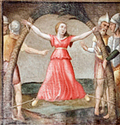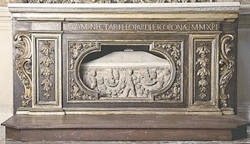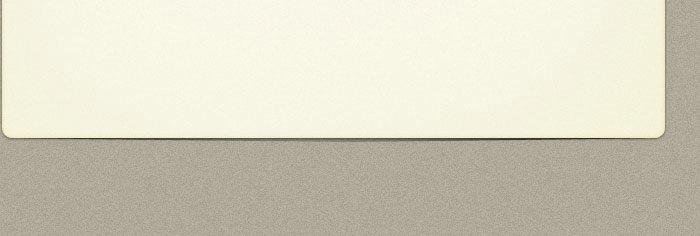



Martyrdom of St Victor and of St Corona
From a panel (16th century) on the counter-facade of Santa Maria Assunta
The Roman Martyrology records under 14th May:
-
“In Syria, the holy martyrs Victor and Corona, under Emperor Antoninus [Marcus Aurelius]. Victor was subjected to diverse and horrible torments by the judge Sebastian. Just then, as Corona, the the wife of a certain soldier, proclaimed him blessed for his constancy in his sufferings, she saw two crowns falling from heaven, one for Victor, the other for herself. She related this to all present, and was torn to pieces between two trees, while Victor was beheaded”.
These saints were recorded in the martyrologies of “Jerome”, Bede, Florus, Adon and Usuard.
They were apparently ‘adopted’ at Ocriculum, as evidenced by two inscriptions (6th century) from San Vittore, Ocriculum. Ludovico Jacobili (referenced below) has him born in Otricoli. He dated the martyrdom to 14th May 168, and had the relics of both saints returned to Italy three years later by Italian soldiers who had served in Syria. The body of St Corona and parts of that of St Victor (including his head) were sent to Otricoli.
St Victor

The first inscription, which surrounds a relief of a Cross and two lambs, records that St Fulgentius discovered the relics of St Victor and erected an altar over his grave:
IVBANTE DEO FVLGENTIVS EPISCOPVS INVENTO CORPORE
MARTYRIS VICTORIS IN XR(IST)I NOMINE SVPER ALTARE CONSTRVXIT
According to Gianfranco Binazzi (referenced below, at p. 6):
-
“The dedicatory inscription is sculpted on the altar (of which only the edge survives) erected by bishop Fulgentius above the tomb of the martyr Victor, which he had discovered in the middle of the 6th century” (my translation).
Ludovico Jacobili (referenced below, at p. 762) recorded that:
-
“This inscription and image an be seen at the foot of the first step of the high altar at [Santa Maria Assunta], having been taken there in 1351 on the occasion of the translation to this church of the relics of St Victor” (my translation).
The inscription is set into the wall of the presbytery, to the left of the high altar.
Ludovico Jacobili (referenced below, at p. 500) recorded that, on the 5th November, 1351:
-
“... Bishop Agostino [Tinacci] of Narni translated the the relics of St Victor, which reposed in the subterranean church dedicated to him beside the Tiber, to [Santa Maria Assunta] and placed them under the high altar, together with the remains of the martyrs SS Eufredius, Januarius and Victoria and two other martyred companions, all of which had been with his at San Vittore” (my translation).
-
✴The reliquary of SS Victor, Eufredius, Januarius and Victoria in the crypt is visible from the window under the high altar.
St Corona

An inscription in Santa Maria Assunta (on the left wall of the presbytery, above the door to the sacristy) once identified the presumed relics of St Corona, together with those of St Fulgentius and other martyrs:
Hic requiescunt S(an)cti Fulgentius
Lozimus Nectarius Leopardus et Corona
martyres C(h)r(ist)i
It is inscribed in a single line on what was probably originally an architrave. Gianfranco Binazzi (referenced below, at p. 7) observed that:
-
“As far as chronology is concerned, both the characters and the formula [used in the inscription] point to a date after the 6th century, but it is otherwise difficult to establish it with precision” (my translation).
Ludovico Jacobili (referenced below, at p. 500) recorded that:
-
“In 1316, Bishop Peter of Narni translated from San Vittore .... to [Santa Maria Assunta] the remains of the martyrs SS Fulgentius, Lozimus Nectarius Leopardus and Corona and placed them under the altar dedicated to St Fulgentius [now the Cappella di Sant’ Antonio Abate, to the left of the presbytery]. ” (my translation).
He gave the precise date at p. 764: 7th May 1316. Ludovico He also recorded (at p. 500) two inscriptions that were placed nearby at this time, one of which was in marble and was almost certainly the inscription transcribed above. It seems likely that this inscription originally belonged to the portal of a room (presumably a crypt) at San Vittore that housed the relics, and that it was moved to Santa Maria Assunta at the time that the relics were translated.

The relics of St Fulgentius were translated to the new chapel of San Fulgenzio in 1672 and are still preserved in the urn under its altar. Those of St Corona and the other martyrs were placed in a small Roman sarcophagus (2nd century AD) in 1675 and placed under an altar in this new chapel in 1675. They were translated to their present location, under the altar of the
Cappella della Madonna del Rosario, in 1730.
Legend of SS Victor and Corona of Otricoli
A later legend (BHL 8583 b-d) used the legend of the Syrian martyrs (probably from the version BHL 8559b) in order to ‘flesh out’ the epigraphical evidence from Ocriculum. Victor and Corona were now martyred at Ocriculum, “intra civitatem, in loco qui dicitur Lico” (in the city, in a place called ‘Lico’), under the auspices of the ‘dux’ Sebastian.
The version BHL 8583d relates to the translation of the relics to the palatine chapel at Aachen by Otto III, who was Holy Roman Emperor in 996- 1002. The first part of the legend is a version In the version of BHL 8583b that oddly concentrates on St Corona, with hardly a mention of St Victor. The persecutor is now ‘Cirinus’ rather than Sebastian, and Corona was buried next to St Leopardus in a crypt in Ocriculum. It ends with an account of Otto’s discovery of the relics under the guidance of an angel. In fact, it seems that the relics that he took to Aachen were those [or, at least some of those] of St Corona: see for example this interesting extract from a paper by Alexandru Stefan (referenced below, at p. 204):
-
“On 27 October 997, Emperor Otto III announced his intention of erecting a Benedictine abbey on the Lousberg, a hill near Aachen, which would be dedicated to ‘Jesus, Saviour of the World, and St Corona’. In order to do this, he acquired some of Corona’s relics from Otricoli and deposited them into a lead reliquary ... at Aachen Cathedral until the completion of the monastery and the consecration of a Coronian chapel. However, he died in 1002 and the Coronian co-patronage over the monastery was not carried out in the end. Nevertheless, the relics of St Corona remained in Aachen Cathedral where, immediately after the death of [Otto III], an altar was dedicated to her. In 1691 the episcopal chapter decided to remove her altar and to relocate the relics in the cathedral crypt”.
Read more:
A. Stefan, “Saint Corona - the First Patron Saint of Medieval Brasov?”, Studia Historia, 58:1 (2013) 201-26
E. D’Angelo, “Otricoli e i Suoi Santi: Storia, Liturgia, Epigrafia, Agiografia”, (2012) Spoleto (pp. 33-41)
G. Binazzi, “Inscriptiones Christianae Italiae: Regio VI; Umbria”, (1989) Bari
L. Jacobili “Vite de’ Santi e Beati dell’ Umbria”, (1647-61, republished in 2008) Sala Bolognese:
-the material on SS Victor and Corona is in Volume I, pp. 494 - 501; and
-the material on St Fulgenius is in Volume I, pp. 760-5
For the historical background, see the page on the history of Otricoli
Return to the page on Saints of Otricoli

